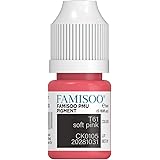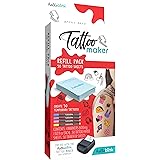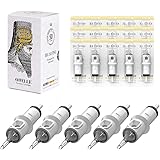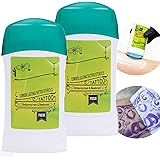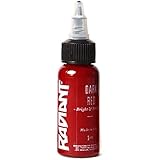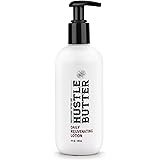While the video above offers a concise visual guide to applying KINK Tattoo Stickers, achieving optimal results and maximizing the longevity of your temporary body art requires a deeper understanding of the process and crucial aftercare considerations. Many enthusiasts of temporary tattoos often encounter issues such as premature fading or uneven application, leading to a less than satisfactory experience. The solution lies in mastering the nuanced techniques that transform a simple sticker into a realistic, enduring design.
KINK Tattoo Stickers leverage advanced semi-permanent ink technology, often involving jagua-based or similar components, which react with the amino acids in the outermost layer of your skin—the epidermis. This reaction facilitates a gradual color development, making proper application and diligent aftercare paramount. Neglecting these steps can significantly compromise the aesthetic integrity and wear time of your chosen design. This comprehensive guide delves into the expert techniques required to ensure your KINK Tattoo Stickers adhere flawlessly, develop beautifully, and last as intended.
Mastering the Initial Application of KINK Tattoo Stickers
The foundation of any successful temporary tattoo application begins long before the sticker even touches your skin. Preparing the canvas—your skin—is a critical first step often overlooked. Conversely, improper skin preparation can lead to poor adhesion and an uneven color development, diminishing the realism of the design.
Skin Preparation: The Unseen Foundation
Prior to applying your KINK Tattoo Sticker, ensure the chosen skin area is meticulously clean, dry, and free from any lotions, oils, or residues. These substances create a barrier between the adhesive and your skin, hindering proper attachment. A gentle wash with soap and water, followed by a thorough drying, is typically sufficient. Some experts recommend a quick wipe with an alcohol swab to remove any lingering dermal oils, though this should be followed by complete drying to prevent irritation.
Furthermore, consider hair removal. While KINK Tattoo Stickers can adhere over fine hair, dense body hair can interfere with the transfer process, resulting in a patchy or incomplete design. For best results, gently shave the area if necessary several hours prior to application to avoid skin sensitivity.
Precision Placement and Adhesion
With your skin prepped, the next phase involves the precise placement of your KINK Tattoo Sticker. The video demonstrates the core mechanics, yet a few expert tips can elevate your application game:
- Choose Your Canvas Wisely: Areas with less friction, fewer creases, and minimal stretching tend to yield better longevity. Think forearms, calves, or the shoulder blade. Constantly flexing joints or areas prone to rubbing against clothing can significantly reduce wear time.
- Remove the Transparent Film Carefully: This protective layer shields the ink. Handle the sticker by its edges to avoid touching the adhesive side. Contaminants from your fingers can impair adhesion.
- Firm & Even Pressure: Once positioned on the skin, apply firm, even pressure. This ensures maximum contact between the sticker’s adhesive and your epidermis. Uneven pressure can lead to sections of the design not transferring fully.
- The Art of Wetting: As shown, wetting the tattoo with water is crucial. However, the quantity and method matter. A saturated sponge or cloth, pressed firmly and evenly over the entire sticker for 20-30 seconds, is ideal. Avoid excessive water that could seep under the sticker or cause the design to bleed. The goal is to fully saturate the paper backing without oversaturating the skin.
- The Peel: After sufficient wetting, gently peel off the sticker. If the design isn’t fully transferring, reapply the wet cloth for a few more seconds. A slow, steady peel minimizes distortion and ensures a clean transfer.
The Critical Phase: Ink Development and Initial Aftercare
Unlike traditional temporary tattoos that display their full design immediately, KINK Tattoo Stickers, like many semi-permanent varieties, undergo a fascinating color rendering process. The video highlights the “COLOR RENDERING EFFECT AFTER 10 HOURS,” a crucial data point that underscores the importance of patience and meticulous initial aftercare.
Understanding the 10-Hour Development Cycle
Upon initial application and removal of the sticker, the design may appear faint, almost colorless, or a very light shade. This is entirely normal. The ink components, typically derived from plant extracts, begin reacting with the organic compounds in your skin. This biochemical process is not instantaneous; it requires time for the pigments to oxidize and darken within the upper layers of the epidermis. This is why the full, vibrant effect takes approximately 10 hours to manifest.
During this critical development period, the tattoo is highly vulnerable. Any disturbance can severely impact the final appearance and longevity. Conversely, adherence to specific care guidelines during these hours can make a significant difference.
The Golden Hours: Immediate Post-Application Care
The video explicitly states, “Do not touch any remaining gel on skin” and “Don’t rub the tattoo within 6 hours.” These instructions are paramount for several reasons:
- Residual Gel: The “remaining gel” is part of the ink formulation, still actively engaging with your skin. Disturbing it can smudge the design, lift nascent pigment, or create an uneven color saturation. Allow it to air dry completely.
- Friction and Abrasion: Rubbing, especially within the first 6 hours, can physically dislodge the developing ink or interfere with the chemical reaction. This can lead to patchy areas, faded lines, or even complete removal of parts of the design before it has a chance to set. Avoid tight clothing or activities that cause skin-on-skin friction in the tattooed area.
- Water Exposure: While the video notes, “You can touch it with water. But I don’t recommend washing as well,” this advises extreme caution. Minimal, incidental contact with water is generally permissible after the initial drying, but full immersion or scrubbing should be avoided. Prolonged water exposure, particularly warm water, can prematurely halt the ink development or cause the design to spread. It is best to avoid showering or heavy sweating for at least the first 6-10 hours.
Longevity and Extended Aftercare Protocols
Once the KINK Tattoo Sticker has fully developed and showcased its intended design, typically after the 10-hour mark, the focus shifts to maintaining its crispness and extending its lifespan. While temporary, with proper care, these tattoos can last significantly longer than their traditional counterparts.
Protecting Your Design from External Factors
Several environmental and lifestyle factors can impact the wear of your KINK Tattoo Sticker. Understanding and mitigating these can ensure your design remains vibrant:
- Moisture Management: After the initial setting period, the tattoo becomes more resilient to water. However, prolonged exposure to hot water, excessive scrubbing, or chlorinated pools can accelerate fading. Pat the area dry gently after showering; do not rub.
- Chemical Avoidance: Sunscreen, lotions, oils, and harsh soaps can all break down the tattoo’s pigment or adhesive layer. Apply these products carefully around the tattoo, rather than directly on it. Alcohol-based products are particularly detrimental.
- UV Radiation: Sun exposure can cause any tattoo, temporary or permanent, to fade. Using a high-SPF sunscreen on your KINK Tattoo Sticker can help protect its color from degradation due to ultraviolet light.
- Friction Reduction: Continuously rubbing the tattoo against clothing, bedding, or other surfaces will inevitably shorten its lifespan. Choose placement areas wisely and opt for looser clothing where possible.
The Science Behind Fading
Ultimately, KINK Tattoo Stickers are designed to be temporary because the ink binds to the outermost layer of skin, which naturally exfoliates. The human skin regenerates continuously, shedding dead skin cells (keratinocytes) from the epidermis. As these cells are replaced, the pigment, which is embedded within them, gradually fades away. This process typically takes anywhere from 7 to 14 days, depending on individual skin type, metabolism, and the specific aftercare regimen. Understanding this natural biological process explains why even the best-cared-for temporary tattoo will eventually disappear.
By integrating these advanced application techniques and rigorous aftercare protocols, users can significantly enhance their experience with KINK Tattoo Stickers. This meticulous approach ensures that each design achieves its full potential, offering a striking, semi-permanent adornment that truly stands out.


